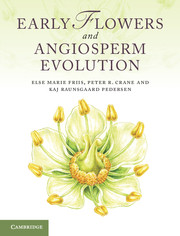Book contents
- Frontmatter
- Contents
- Preface
- 1 Introduction to angiosperms
- 2 The nature of the angiosperm fossil record
- 3 The environmental context of early angiosperm evolution
- 4 Stratigraphic framework and key areas for Cretaceous angiosperms
- 5 Angiosperms in context: extant and fossil seed plants
- 6 Origin and age of angiosperms
- 7 Phylogenetic framework and the assignment of fossils to extant groups
- 8 Fossils near the base of the angiosperm tree
- 9 Early fossil angiosperms of uncertain relationships
- 10 Early fossils of eumagnoliids
- 11 Fossils of monocots
- 12 Fossils of eudicots: early-diverging groups
- 13 Fossils of core eudicots: basal lineages
- 14 Fossils of core eudicots: rosids
- 15 Early fossils of eudicots: asterids
- 16 Patterns of structural diversification in angiosperm reproductive organs
- 17 History and evolution of pollination in angiosperms
- 18 History and evolution of dispersal in angiosperms
- 19 Vegetational context of early angiosperm diversification
- 20 The accumulation of angiosperm diversity
- References
- Index
10 - Early fossils of eumagnoliids
Published online by Cambridge University Press: 07 September 2011
- Frontmatter
- Contents
- Preface
- 1 Introduction to angiosperms
- 2 The nature of the angiosperm fossil record
- 3 The environmental context of early angiosperm evolution
- 4 Stratigraphic framework and key areas for Cretaceous angiosperms
- 5 Angiosperms in context: extant and fossil seed plants
- 6 Origin and age of angiosperms
- 7 Phylogenetic framework and the assignment of fossils to extant groups
- 8 Fossils near the base of the angiosperm tree
- 9 Early fossil angiosperms of uncertain relationships
- 10 Early fossils of eumagnoliids
- 11 Fossils of monocots
- 12 Fossils of eudicots: early-diverging groups
- 13 Fossils of core eudicots: basal lineages
- 14 Fossils of core eudicots: rosids
- 15 Early fossils of eudicots: asterids
- 16 Patterns of structural diversification in angiosperm reproductive organs
- 17 History and evolution of pollination in angiosperms
- 18 History and evolution of dispersal in angiosperms
- 19 Vegetational context of early angiosperm diversification
- 20 The accumulation of angiosperm diversity
- References
- Index
Summary
Different applications of the magnoliid concept, and different conclusions as to which families should be included in the group, are a potential source of confusion in understanding early angiosperm evolution (Chapters 7, 8). However, recent phylogenetic studies have greatly clarified the situation and provide a firm basis for interpreting fossil material related to this important group of angiosperms. In this chapter we provide a brief outline of the current classification of eumagnoliids, and a review of those fossils, mainly from the Cretaceous, that can be assigned to the group. The fossil history of eumagnoliids is extensive, particularly from the Cenozoic, but there are also well-preserved and informative fossils from the Cretaceous. The early fossil record of eumagnoliids continues to increase rapidly as new palaeobotanical discoveries are made.
Classification of eumagnoliids
In the classification of Takhtajan (e.g. 1969) subclass Magnoliidae included six orders (Magnoliales, Laurales, Piperales, Aristolochiales, Rafflesiales, Nymphaeales), but it is now clear from phylogenetic analyses based on molecular data that this group is not monophyletic (e.g. Soltis et al., 2005; APGIII, 2009). Several families are now recognised to comprise the ANITA grade; others have been placed elsewhere in the angiosperm tree. Four orders, Magnoliales, Laurales, Piperales and Canellales (Zanis et al., 2003; APGIII, 2009), which were at the core of the former subclass Magnoliidae, comprise a monophyletic group, termed eumagnoliids by Soltis et al. (2000b) and magnoliids by APGIII (2009). Here we follow Soltis et al. (2000b) and refer to Magnoliales, Laurales, Piperales and Canellales as eumagnoliids. We use magnoliids informally in the broader conventional sense (Chapter 7). Magnoliales and Laurales form a clade that is sister to a clade comprising Piperales plus Canellales.
- Type
- Chapter
- Information
- Early Flowers and Angiosperm Evolution , pp. 219 - 248Publisher: Cambridge University PressPrint publication year: 2011



